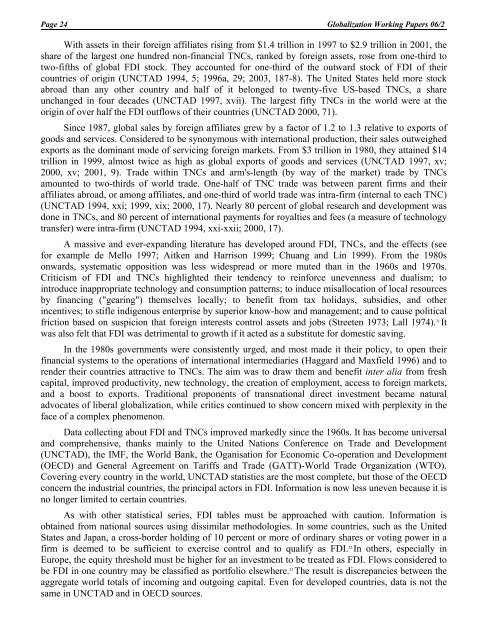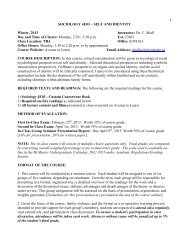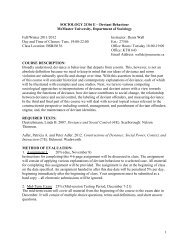samir saul2 sz.pub - Faculty of Social Sciences - McMaster University
samir saul2 sz.pub - Faculty of Social Sciences - McMaster University
samir saul2 sz.pub - Faculty of Social Sciences - McMaster University
You also want an ePaper? Increase the reach of your titles
YUMPU automatically turns print PDFs into web optimized ePapers that Google loves.
Page 24 Globalization Working Papers 06/2<br />
With assets in their foreign affiliates rising from $1.4 trillion in 1997 to $2.9 trillion in 2001, the<br />
share <strong>of</strong> the largest one hundred non-financial TNCs, ranked by foreign assets, rose from one-third to<br />
two-fifths <strong>of</strong> global FDI stock. They accounted for one-third <strong>of</strong> the outward stock <strong>of</strong> FDI <strong>of</strong> their<br />
countries <strong>of</strong> origin (UNCTAD 1994, 5; 1996a, 29; 2003, 187-8). The United States held more stock<br />
abroad than any other country and half <strong>of</strong> it belonged to twenty-five US-based TNCs, a share<br />
unchanged in four decades (UNCTAD 1997, xvii). The largest fifty TNCs in the world were at the<br />
origin <strong>of</strong> over half the FDI outflows <strong>of</strong> their countries (UNCTAD 2000, 71).<br />
Since 1987, global sales by foreign affiliates grew by a factor <strong>of</strong> 1.2 to 1.3 relative to exports <strong>of</strong><br />
goods and services. Considered to be synonymous with international production, their sales outweighed<br />
exports as the dominant mode <strong>of</strong> servicing foreign markets. From $3 trillion in 1980, they attained $14<br />
trillion in 1999, almost twice as high as global exports <strong>of</strong> goods and services (UNCTAD 1997, xv;<br />
2000, xv; 2001, 9). Trade within TNCs and arm's-length (by way <strong>of</strong> the market) trade by TNCs<br />
amounted to two-thirds <strong>of</strong> world trade. One-half <strong>of</strong> TNC trade was between parent firms and their<br />
affiliates abroad, or among affiliates, and one-third <strong>of</strong> world trade was intra-firm (internal to each TNC)<br />
(UNCTAD 1994, xxi; 1999, xix; 2000, 17). Nearly 80 percent <strong>of</strong> global research and development was<br />
done in TNCs, and 80 percent <strong>of</strong> international payments for royalties and fees (a measure <strong>of</strong> technology<br />
transfer) were intra-firm (UNCTAD 1994, xxi-xxii; 2000, 17).<br />
A massive and ever-expanding literature has developed around FDI, TNCs, and the effects (see<br />
for example de Mello 1997; Aitken and Harrison 1999; Chuang and Lin 1999). From the 1980s<br />
onwards, systematic opposition was less widespread or more muted than in the 1960s and 1970s.<br />
Criticism <strong>of</strong> FDI and TNCs highlighted their tendency to reinforce unevenness and dualism; to<br />
introduce inappropriate technology and consumption patterns; to induce misallocation <strong>of</strong> local resources<br />
by financing ("gearing") themselves locally; to benefit from tax holidays, subsidies, and other<br />
incentives; to stifle indigenous enterprise by superior know-how and management; and to cause political<br />
friction based on suspicion that foreign interests control assets and jobs (Streeten 1973; Lall 1974). 31 It<br />
was also felt that FDI was detrimental to growth if it acted as a substitute for domestic saving.<br />
In the 1980s governments were consistently urged, and most made it their policy, to open their<br />
financial systems to the operations <strong>of</strong> international intermediaries (Haggard and Maxfield 1996) and to<br />
render their countries attractive to TNCs. The aim was to draw them and benefit inter alia from fresh<br />
capital, improved productivity, new technology, the creation <strong>of</strong> employment, access to foreign markets,<br />
and a boost to exports. Traditional proponents <strong>of</strong> transnational direct investment became natural<br />
advocates <strong>of</strong> liberal globalization, while critics continued to show concern mixed with perplexity in the<br />
face <strong>of</strong> a complex phenomenon.<br />
Data collecting about FDI and TNCs improved markedly since the 1960s. It has become universal<br />
and comprehensive, thanks mainly to the United Nations Conference on Trade and Development<br />
(UNCTAD), the IMF, the World Bank, the Oganisation for Economic Co-operation and Development<br />
(OECD) and General Agreement on Tariffs and Trade (GATT)-World Trade Organization (WTO).<br />
Covering every country in the world, UNCTAD statistics are the most complete, but those <strong>of</strong> the OECD<br />
concern the industrial countries, the principal actors in FDI. Information is now less uneven because it is<br />
no longer limited to certain countries.<br />
As with other statistical series, FDI tables must be approached with caution. Information is<br />
obtained from national sources using dissimilar methodologies. In some countries, such as the United<br />
States and Japan, a cross-border holding <strong>of</strong> 10 percent or more <strong>of</strong> ordinary shares or voting power in a<br />
firm is deemed to be sufficient to exercise control and to qualify as FDI. 32 In others, especially in<br />
Europe, the equity threshold must be higher for an investment to be treated as FDI. Flows considered to<br />
be FDI in one country may be classified as portfolio elsewhere. 33 The result is discrepancies between the<br />
aggregate world totals <strong>of</strong> incoming and outgoing capital. Even for developed countries, data is not the<br />
same in UNCTAD and in OECD sources.




